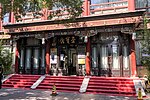Zhengyici Peking Opera Theatre
Chinese music stubsChinese opera theatresPeking operaPeople's Republic of China building and structure stubsTheatre (structure) stubs ... and 2 more
Theatres in BeijingTourist attractions in Beijing
The Zhengyici Peking Opera Theatre (Chinese: 正乙祠戏楼; pinyin: Zhèngyǐcí Xìlóu), located on a hutong in the Xuanwu District of Beijing, is one of the best-known Beijing opera theatres. It is also one of the oldest wooden theatres in China. Zhengyici means a temple (ci) for Zhengyi Xuantan Laozu (正乙玄坛老祖).
Excerpt from the Wikipedia article Zhengyici Peking Opera Theatre (License: CC BY-SA 3.0, Authors).Zhengyici Peking Opera Theatre
Qianmenxihe Str, Xicheng District Dashilan (首都功能核心区)
Geographical coordinates (GPS) Address Nearby Places Show on map
Geographical coordinates (GPS)
| Latitude | Longitude |
|---|---|
| N 39.897404 ° | E 116.379847 ° |
Address
前门西河沿街
Qianmenxihe Str
100032 Xicheng District, Dashilan (首都功能核心区)
Beijing, China
Open on Google Maps









